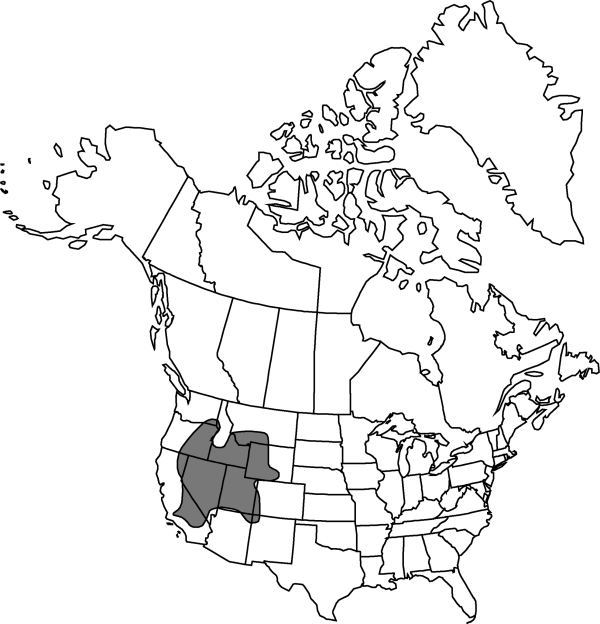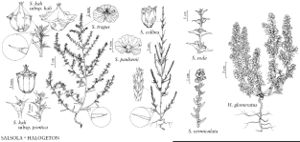Difference between revisions of "Halogeton glomeratus"
in C. F. von Ledebour, Icon. Pl. 1: 10. 1829.
FNA>Volume Importer |
imported>Volume Importer |
||
| (3 intermediate revisions by 2 users not shown) | |||
| Line 1: | Line 1: | ||
{{Treatment/ID | {{Treatment/ID | ||
|accepted_name=Halogeton glomeratus | |accepted_name=Halogeton glomeratus | ||
| − | |accepted_authority=(M. Bieberstein) C. A. Meyer | + | |accepted_authority=(M. Bieberstein) C. A. Meyer |
|publications={{Treatment/Publication | |publications={{Treatment/Publication | ||
|title=in C. F. von Ledebour, Icon. Pl. | |title=in C. F. von Ledebour, Icon. Pl. | ||
| Line 8: | Line 8: | ||
}} | }} | ||
|common_names=Saltlover | |common_names=Saltlover | ||
| + | |special_status={{Treatment/ID/Special_status | ||
| + | |code=W | ||
| + | |label=Weedy | ||
| + | }}{{Treatment/ID/Special_status | ||
| + | |code=I | ||
| + | |label=Introduced | ||
| + | }}{{Treatment/ID/Special_status | ||
| + | |code=F | ||
| + | |label=Illustrated | ||
| + | }} | ||
|basionyms={{Treatment/ID/Basionym | |basionyms={{Treatment/ID/Basionym | ||
|name=Anabasis glomerata | |name=Anabasis glomerata | ||
|authority=M. Bieberstein | |authority=M. Bieberstein | ||
| + | |rank=species | ||
|publication_title=Mém. Soc. Imp. Naturalist es Moscou | |publication_title=Mém. Soc. Imp. Naturalist es Moscou | ||
|publication_place=1: 110. 1808 | |publication_place=1: 110. 1808 | ||
| Line 29: | Line 40: | ||
|elevation=1200-2100 m | |elevation=1200-2100 m | ||
|distribution=Ariz.;Calif.;Colo.;Idaho;Mont.;Nev.;N.Mex.;Oreg.;Utah;Wash.;Wyo.;native to Eurasia. | |distribution=Ariz.;Calif.;Colo.;Idaho;Mont.;Nev.;N.Mex.;Oreg.;Utah;Wash.;Wyo.;native to Eurasia. | ||
| + | |introduced=true | ||
|discussion=<p>A noxious and toxic weed in disturbed, barren, alkaline soils, <i>Halogeton glomeratus</i> is able to withstand high concentrations of salinity. It is often associated with <i>Sarcobatus vermiculatus</i> and <i>Atriplex confertifolia</i> and is found in the cold deserts of western United States.</p><!-- | |discussion=<p>A noxious and toxic weed in disturbed, barren, alkaline soils, <i>Halogeton glomeratus</i> is able to withstand high concentrations of salinity. It is often associated with <i>Sarcobatus vermiculatus</i> and <i>Atriplex confertifolia</i> and is found in the cold deserts of western United States.</p><!-- | ||
--><p>The first collection of <i>Halogeton</i> in the United States was by Ben Stahmann in Wells, <i>Nevada</i>, in 1934. It was not until the fall of 1942, when a herder lost 160 sheep, that the species was recognized as toxic to livestock (J. A. Young et al. 1999).</p> | --><p>The first collection of <i>Halogeton</i> in the United States was by Ben Stahmann in Wells, <i>Nevada</i>, in 1934. It was not until the fall of 1942, when a herder lost 160 sheep, that the species was recognized as toxic to livestock (J. A. Young et al. 1999).</p> | ||
| Line 39: | Line 51: | ||
-->{{#Taxon: | -->{{#Taxon: | ||
name=Halogeton glomeratus | name=Halogeton glomeratus | ||
| − | + | |authority=(M. Bieberstein) C. A. Meyer | |
| − | |authority=(M. Bieberstein) C. A. Meyer | ||
|rank=species | |rank=species | ||
|parent rank=genus | |parent rank=genus | ||
| Line 54: | Line 65: | ||
|publication title=in C. F. von Ledebour, Icon. Pl. | |publication title=in C. F. von Ledebour, Icon. Pl. | ||
|publication year=1829 | |publication year=1829 | ||
| − | |special status= | + | |special status=Weedy;Introduced;Illustrated |
| − | |source xml=https:// | + | |source xml=https://bitbucket.org/aafc-mbb/fna-data-curation/src/2e0870ddd59836b60bcf96646a41e87ea5a5943a/coarse_grained_fna_xml/V4/V4_798.xml |
|genus=Halogeton | |genus=Halogeton | ||
|species=Halogeton glomeratus | |species=Halogeton glomeratus | ||
Latest revision as of 22:00, 5 November 2020
Stems: main terminal stem erect, lateral 4 decumbent to spreading from base, 1–4 dm, the 5 stems becoming much branched in vigorous plants. Leaf blades linear, 4–14(–17) mm. Inflorescence: each axillary group typically 3 glomerulate with, 2 lateral bracteate, (1–)2–3-flowered glomerules and a pistillate, 1-flowered, ebracteate one between. Perianth 5-parted from near base, well developed in bisexual flowers, segments differentiated into 2–3 mm claw and 2–4 mm-wide blade; blade flabelliform, firm, transparent-membranous; segments of central flower developing earlier than lateral ones, without blade; stamens 3–5; filaments connate into 2 clusters of 2 or 3. Utricles vertical, dimorphic, associated with 2 types of flowers, lateral ones blackish, 0.5–1 mm, central one brown, 1–2 mm. 2n = 18.
Phenology: Flowering Jul–Aug; fruiting fall.
Habitat: Disturbed, barren, alkaline soils
Elevation: 1200-2100 m
Distribution

Introduced; Ariz., Calif., Colo., Idaho, Mont., Nev., N.Mex., Oreg., Utah, Wash., Wyo., native to Eurasia.
Discussion
A noxious and toxic weed in disturbed, barren, alkaline soils, Halogeton glomeratus is able to withstand high concentrations of salinity. It is often associated with Sarcobatus vermiculatus and Atriplex confertifolia and is found in the cold deserts of western United States.
The first collection of Halogeton in the United States was by Ben Stahmann in Wells, Nevada, in 1934. It was not until the fall of 1942, when a herder lost 160 sheep, that the species was recognized as toxic to livestock (J. A. Young et al. 1999).
Selected References
None.
